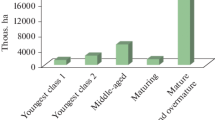Abstract
The article discusses the conceptual framework for forestry policy. Monitoring of indicators of the forestry sector of the Republic of Mari El, rates of natural and artificial reforestation, foci of forest destruction with fires, emissions of harmful substances into the atmosphere, etc., are presented. General principles and main directions of development of the forest industry are presented.




Similar content being viewed by others
Notes
The reasons for exceeding the calculated cutting area, as a rule, are that the wood is harvested mainly in areas close to transport hubs. In these areas, the estimated valuable cutting areas are often exceeded, as a result of which the cuttings are overgrown with birch and other low-value species.
In accordance with the economic, environmental and social significance of the forest fund, its location and the functions performed by it, the forest fund is divided into groups of forests and the forests of the first group are distinguished into protection categories. The forests of the first group include forests, the main purpose of which is to fulfill water protection, protective, sanitary and hygienic, health and other functions, as well as forests of specially protected natural territories. The forests of the second group include forests in regions with a high population density and a developed network of land transport routes, forests performing water protection, protective, sanitary and hygienic, health and other functions of limited operational importance, as well as forests in regions with insufficient forest resources, where restrictions on forest use are required for conservation.
REFERENCES
Federal Forestry Agency. http://www.rosleshoz. gov.ru/dep/volga/regions.
V. K. Fal’tsman, “On measurement of economic growth,” Stud. Russ. Econ. Dev. 29 (1), 6–11 (2018).
V. V. Ivanter, O. Dzh. Govtvan’, M. S. Gusev, M. Yu. Ksenofontov, D. B. Kuvalin, A. K. Moiseev, B. N. Porfiryev, V. V. Semikashev, M. N. Uzyakov, and A. A. Shirov, “System of measures to recovery of economic growth in Russia,” Stud. Russ. Econ. Dev. 29 (1), 1–5 (2018).
V. L. Chernykh, S. A. Denisov, K. K. Kalinin, E. A. Smolentseva, T. V. Mochaeva, T. V. Nureeva, D. I. Mukhortov, K. P. Rukomoinikov, P. A. Nekhoroshkov, V. V. Chernykh, Innovative Development of the Forestry Cluster of the North-Eastern Territories of the Samara Region: Monograph (Povolzh. Gos. Tekh. Univ., Ioshkar-Ola, 2015).
The Forest Code of the Russian Federation (Federal Law of December 4, 2006 No. 200-FZ) (Omega-L, Moscow, 2007) [in Russian].
S. A. Kravchenko, “The humanistic concept of T. Lukman and the nonlinear realities of Russia’s society,” Sotsis, No. 8, 24–26 (2006).
Ministry of Natural Resources, Ecology, and Environmental Protection of the Republic of Mari El. http://mari-el.gov.ru/minles/Pages/about.aspx.
Funding
The article was prepared with the support of the Russian Foundation for Fundamental Research under the grant (project No. 18-010-00990\18).
Author information
Authors and Affiliations
Corresponding author
Ethics declarations
The authors declare that they have no conflict of interest.
Additional information
Translated by S. Avodkova
Rights and permissions
About this article
Cite this article
Chernykh, V.V. Features and Problems of the Forestry Sector Development in the Republic of Mari El. Stud. Russ. Econ. Dev. 30, 467–473 (2019). https://doi.org/10.1134/S1075700719040038
Received:
Revised:
Accepted:
Published:
Issue Date:
DOI: https://doi.org/10.1134/S1075700719040038




